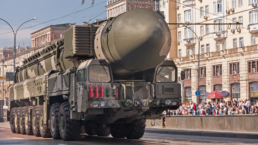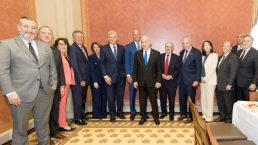By Cathleen Falsani, Outrider
One of the more disturbing religious images to make the viral rounds on social media in recent months shows a Russian Orthodox clergyman in red-and-gold vestments standing beside a massive intercontinental ballistic missile as he flings holy water at the delivery system for a nuclear bomb—not to exorcise it, but to bless it.

Now that Russian President Vladimir Putin has threatened to use nuclear or other weapons of mass destruction offensively in his war on Ukraine, the optics have changed. Russia’s long-standing military doctrine says nuclear arms should be used only as a defensive measure and in the case of an “existential threat” to the motherland. As Putin threatens NATO and justifies the war as a defense of historical Russia, the specter of nuclear annihilation haunts popular consciousness in a way it hasn’t since the height of the Cold War.
Yet, as bizarre as it might seem, the blessing of weapons of war (and war itself) is not unusual in today’s Russian Orthodox Church (ROC) inside Russia. Since the fall of the Soviet Union in 1991, the native ROC evolved from a persecuted religious body to, at least functionally, an arm of the Kremlin—the same government that officially suppressed all religions for 70 years during the Soviet era when atheism was the official ideology of the Communist Party.
“The [Russian Orthodox] Church is now one of the propaganda tools for the Kremlin and Putin,” said Sergei Chapnin, a senior fellow at Fordham University’s Orthodox Christian Studies Center and former deputy editor-in-chief of Moscow Patriarchate publishing house, the official publishing house of the Russian Orthodox Church.
Recent Posts
Why Are Democratic Lawmakers Still Meeting With Netanyahu?
July 12, 2025
Take Action Now Pictures show Democrats like Chuck Schumer standing next to Netanyahu, smiling.By Sharon Zhang, Truthout A bipartisan group of…
Stop Israel’s Dystopian “Humanitarian City” Plan—Before It’s Too Late
July 11, 2025
Take Action Now For the past 20 months, the world has watched—and largely enabled—a genocidal campaign in Gaza. Over 55,000 Palestinians have been…
The “Liberal” International Order Is Criminalizing Palestine Protests
July 11, 2025
Take Action Now As Western governments repress Palestine solidarity and enable Israel’s impunity, the “liberal international order” is no longer…
Politicians Are Betraying Gen Z On Climate
July 10, 2025
Take Action Now While Gen-Zers thrift, knit, crochet, and find other ways to reduce our footprints, Trump and the GOP are greenlighting more climate…




